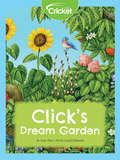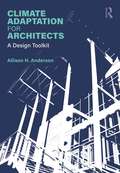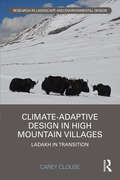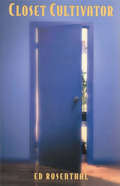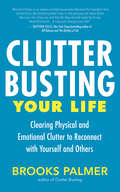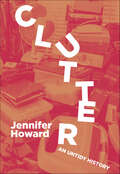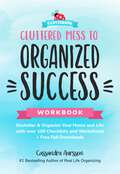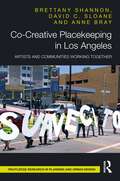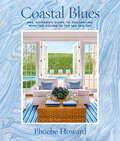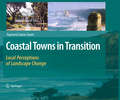- Table View
- List View
Clever Cleaning: The natural way to clean everything
by Charlotte Figg Purdy Rubin'The only book that could turn cleaning into a love affair.' JO GOOD, radio presenterSince when did cleaning become so complicated?Purdy Rubin and Charlotte Figg were just like us - fed up with all those plastic spray bottles full of harsh chemicals under the kitchen sink, most of which were never used. So together they embarked on a mission to find a better solution. The result? Purdy & Figg, the UK's fastest-growing natural cleaning brand. In this beautifully illustrated book, Purdy and Charlotte share their knowledge and show us how just a few natural hero ingredients can more than hold their own against 'Big Clean', especially when combined into their easy-to-make recipes.Inside you'll discover: ☀︎ Practical tips for everything from zero-effort oven ☀︎ cleaning and getting rid of limescale to banishing moths. ☀︎ Bullet-proof instructions for tackling every stain, from avocado to rust. ☀︎ How to make your home smell like a gorgeous natural spa. Clever Cleaning is about making cleaning simpler, calmer and a little more joyful.
Click's Dream Flower Garden
by Carol Schwartz Amy TaoClick loves flowers! If he could have anything he wanted in his garden, he would choose flowers with a variety of different seeds, bulbs, leaves, and stems so he could enjoy all sorts of pretty colors and interesting plants! Did you know that orange blossoms turn into fruit, or that a pussy willow’s flowers are called a catkin? Follow along with Click and learn all sorts of cool flower stuff!
Climate Action Planning: A Guide to Creating Low-Carbon, Resilient Communities
by Michael R. Boswell Adrienne I. Greve Ms Tammy L. SealeClimate change continues to impact our health and safety, the economy, and natural systems. With climate-related protections and programs under attack at the federal level, it is critical for cities to address climate impacts locally. Every day there are new examples of cities approaching the challenge of climate change in creative and innovative ways—from rethinking transportation, to greening city buildings, to protecting against sea-level rise. Climate Action Planning is designed to help planners, municipal staff and officials, citizens and others working at local levels to develop and implement plans to mitigate a community's greenhouse gas emissions and increase the resilience of communities against climate change impacts. This fully revised and expanded edition goes well beyond climate action plans to examine the mix of policy and planning instruments available to every community. Boswell, Greve, and Seale also look at process and communication: How does a community bring diverse voices to the table? What do recent examples and research tell us about successful communication strategies? Climate Action Planning brings in new examples of implemented projects to highlight what has worked and the challenges that remain. A completely new chapter on vulnerability assessment will help each community to identify their greatest risks and opportunities. Sections on land use and transportation have been expanded to reflect their growing contribution to greenhouse gas emissions. The guidance in the book is put in context of international, national, and state mandates and goals. Climate Action Planning is the most comprehensive book on the state of the art, science, and practice of local climate action planning. It should be a first stop for any local government interested in addressing climate change.
Climate Adaptation for Architects: A Design Toolkit
by Allison AndersonArchitecture must adapt to protect people from the threat of climate change. About half of the world’s population lives in contexts that are highly vulnerable to climate change as hazards continue to intensify, with global disasters projected to reach 560 events per year by 2030, or 1.5 events every day. The accelerating frequency and intensity of disasters underscores the urgency to prepare for severe events to protect people, communities, and essential systems but also to protect the environment which provides shelter, livelihoods, cultural heritage, and public functions. This book provides a comprehensive reference of climate adaptation design tactics and a toolkit for adaptation to shocks and stresses, outlining the process for architects and designers to: Understand the risks posed by climate change to the built environment. Reduce the risks to people and the built environment from natural hazards. Reduce human vulnerability to shocks and stresses by strengthening resilience and adaptive capacity. Design the built environment to adapt to changes over its lifetime. Design buildings and cities to reduce dependence on fossil fuels. Preserve biodiversity and support natural resources. Climate Adaptation for Architects presents 45 adaptation tactics responding to the most consequential effects of climate change: heat, water, wind, and resource scarcity. Each chapter includes images, a definition, background information, key design considerations, potential impacts, and resources for further information. This is a valuable resource for every architect, landscape architect, urban planner, developer, and policymaker.
Climate Adaptation in Urban Planning: Toward Sustainable and Resilient Urban Environments (SpringerBriefs in Architectural Design and Technology)
by Simona MannucciThis book provides an overview of the current planning paradigms and technical strategies to cope with climate change, specifically flooding. Architecture and planning face the challenging task of designing the built environment while addressing complex issues in urban areas. Factors such as climate change, societal and economic issues and population growth can significantly impact the success of a plan. In order to plan for the future, adaptation and flexibility have become crucial. However, the traditional deterministic approach in planning allows no room for failure, expecting plans and projects to achieve desired objectives regardless of how the future unfolds. It also explores new planning paradigms, methods, and tools from other disciplines that can be integrated into urban planning to achieve long-term, flexible adaptation in the face of uncertain conditions (Decision Making Under Deep Uncertainty—DMDU). Additionally, a case study is presented, focusing on addressing uncertainties in a flood-prone area in Rome through scenario planning, combining various cutting-edge model-based methodologies drawn from DMDU. The target audiences are researchers and practitioners in architecture and urban planning.
Climate-Adaptive Design in High Mountain Villages: Ladakh in Transition (Routledge Research in Landscape and Environmental Design)
by Carey ClouseDrawing from the unique context and climate of the Himalaya, this book highlights several innovative design interventions, shaped by a myriad of social, cultural, environmental, and political factors that have been employed in villages to combat climate change. Climate-Adaptive Design in High Mountain Villages focuses on Ladakh, an outpost on the front lines of climate change, and the region’s creative responses to the pressing issues of food security, water management, energy efficiency, design aid, and material resources in the Anthropocene. These strategies – from artificial glaciers to tree armor – showcase the breadth of creative solutions already underway. In doing so, the research addresses the broader concept of climate-adaptive design and how it informs the disciplines of architecture, landscape architecture, and urban planning. An ideal read for academics, researchers, and students in these fields, this book presents a focused investigation into climate-adaptive strategies that could provide transferable solutions for the rest of the world.
Climate-Wise Landscaping: Practical Actions for a Sustainable Future, Second Edition
by Sue Reed Ginny StiboltWhat can we do, right now, in our own landscapes, to help solve climate change? Gold Winner, Foreword INDIES Book Awards: Ecology & Environment “Read this book carefully. Everything you need to know to help heal our relationship with planet Earth and empower you to make a much-needed difference is within these pages.”—From the foreword by Doug Tallamy Praise for the first edition: “The volume of information here is impressive, and each action is accompanied by an explanation of why it’s important. . . . Useful whether read cover-to-cover or dipped into for specific topics.”—Booklist“Beautifully designed, the book is user-friendly and attractive. The information is current and science-based, with end-notes that give readers access to further research.”—Virginia Native Plant Society “This fantastic resource is filled with climate-wise solutions for anyone who owns or manages a piece of ground—even if it’s just a few containers on a tiny rooftop garden.”—Claudia West, ASLA, Principal, Phyto Studio LLC “[Reed and Stibolt] articulate a new gardening aesthetic. . . . The result is a positive and hopeful story of how people can use their imagination and ingenuity to help craft more resilient landscapes.”—Dr. Peter Robinson, former CEO, David Suzuki Foundation “Beautiful photos and pleasing graphics illustrate key ideas and actions while informative sidebars and inspiring quotes from climate and landscape experts provide clarity of complex systems and motivation to adapt to a changing future.”—Julie Richburg, Ph.D., ecologist “A book on climate-wise landscaping could not be more timely or more necessary. We are moving into a new and critical era, and this book takes landscape professionals and home gardeners where they need to go.”—Owen Dell, RLA, ASLA, landscape architect, educator, author, Owen Dell & Associates “A very useful guide to designing landscapes for the twenty-first century which clearly respond to our changing climate.”—Darrel Morrison, honorary associate faculty member in landscape architecture, University of Wisconsin-Madison Predictions about future effects of climate change range from mild to dire—but we’re already seeing warmer winters, hotter summers, and more extreme storms. Proposed solutions often seem expensive and complex and can leave us as individuals at a loss, wondering what, if anything, can be done.Sue Reed and Ginny Stibolt offer a rallying cry in response—instead of wringing our hands, let's roll up our sleeves. Based on decades of the authors' experience, this book is packed with simple, practical steps anyone can take to beautify any landscape or garden, while helping protect the planet and the species that call it home. Topics include: Working actively to shrink our carbon footprint through mindful landscaping and gardeningCreating cleaner air and waterMaximizing resource efficiencySupporting birds, butterflies, pollinators, and other wildlife. As climate change continues to intensify around the globe, the information in this second edition of Climate-Wise Landscaping is needed now more than ever. This book is the ideal tool for homeowners, gardeners, and landscape professionals who want to be part of the solution to climate change.
Clondeglass: Creating A Garden Paradise
by Dermot O'NeillWhen Dermot O'Neill bought Clondeglass over a decade ago, the derelict house and totally overgrown walled garden were on the edge of collapse. Here, Dermot takes us on a tour of the different sections of the totally renovated garden, showing his particular plant passions and interests, covering trees, shrubs, perennials, bulbs and structures. We start in the Rose Garden, exploring the wide range of roses, before moving onto the Double Borders and Courtyard. Inside the Polytunnel we find a host of vegetables and more tropical plants. Then along the West Border we come to The Temple, a timber haven to relax and escape the rain! The Potager is devoted to vegetables and fruit trees, including a number of rare species and Irish heritage varieties. Finally The Poultry, with Dermot's own Toulouse geese. Remarkable before and after photographs document the enormous changes, as well as plans to show what's still to come.
Clondeglass: Creating a Garden Paradise
by Dermot O'NeillWhen Dermot O'Neill bought Clondeglass over a decade ago, the derelict house and totally overgrown walled garden were on the edge of collapse. Here, Dermot takes us on a tour of the different sections of the totally renovated garden, showing his particular plant passions and interests, covering trees, shrubs, perennials, bulbs and structures. We start in the Rose Garden, exploring the wide range of roses, before moving onto the Double Borders and Courtyard. Inside the Polytunnel we find a host of vegetables and more tropical plants. Then along the West Border we come to The Temple, a timber haven to relax and escape the rain! The Potager is devoted to vegetables and fruit trees, including a number of rare species and Irish heritage varieties. Finally The Poultry, with Dermot's own Toulouse geese. Remarkable before and after photographs document the enormous changes, as well as plans to show what's still to come.
Closer to the Ground
by Thomas Mcguane Nikki Mcclure Dylan TomineCloser to the Ground is the deeply personal story of a father learning to share his love of nature with his children, not through the indoor lens of words or pictures, but directly, palpably, by exploring the natural world as they forage, cook and eat from the woods and sea. With illustrations by Nikki McClure.This compelling, masterfully written tale follows Dylan Tomine and his family through four seasons as they hunt chanterelles, fish for salmon, dig clams and gather at the kitchen table, mouths watering, to enjoy the fruits of their labor. Closer to the Ground captures the beauty and surprise of the natural world-and the ways it teaches us how to live-with humor, gratitude and a nose for adventure as keen as a child's. It is a book filled with weather, natural history and many delicious meals.
Closet Cultivator
by Ed RosenthalWritten in clear, easy-to-understand language for the novice grower, Closet Cultivator is the ultimate secret growing guide. The author discusses lighting, nutrients, water systems, potency, and more, and he shows how to establish a high-yield garden in a limited space -- and on a limited budget.
Closet Cultivator: Growing Marijuana Indoors
by Ed RosenthalWritten in clear, easy-to-understand language for the novice grower, Closet Cultivator is the ultimate secret growing guide. The author discusses lighting, nutrients, water systems, potency, and more, and he shows how to establish a high-yield garden in a limited space -- and on a limited budget.
Clutter Busting Your Life
by Brooks PalmerOver the course of his career helping people let go of things they no longer need, Brooks Palmer has been struck by the many ways that clutter affects relationships. In these pages, he shows how we use clutter to protect ourselves, control others, and cling to the past, and how it keeps us from experiencing the joy of connection. With insight-prompting questions, exercises, client examples, and even whimsical line drawings, Palmer will take you from overwhelmed to empowered. His gentle guidance will help you to not only clear clutter from your home but also enjoy deeper, more authentic, and clutter-free relationships of all kinds.
Clutter Busting: Letting Go of What's Holding You Back
by Brooks PalmerPiles of junk in garages and closets, overflowing papers on desks, items unused for years, masses of unanswered email, clothing never worn, useless gifts that collect dust; all these things, says Brooks Palmer, come weighted with shame and guilt and have a suffocating effect on spirit and soul. In this insightful book, Palmer shows how to get rid of the things in our lives that no longer serve us. By tossing out these unneeded items, we are also eliminating their negative influences, freeing up energy, and unlocking our potential. Loaded with inspiring anecdotes and practical tips, Clutter Busting is based on the premise that your things are not sacred, but you are. The book explores such fundamental topics as the false identities we assume through clutter, the fear of change those junk piles represent, the addictive nature of holding on to objects, how clearing clutter makes room for clarity and sweeps away confusion and stasis, and much more. With Brooks’s upbeat and compassionate guidance, you’ll find yourself clearing the way for new and exciting things to come into your life.
Clutter Control
by Jeff CampbellLearn how to make the most of available space, set up practical anti-clutter systems, organize hot spot storage and find storage space in places you never dreamed of.NOTE: This edition does not include illustrations.
Clutter Rehab: 101 Tips and Tricks to Become an Organization Junkie and Love It!
by Laura WittmannCUT THE CLUTTER AND TAKE CONTROL OF YOUR HOME!With 101 quick-and-easy projects for organizing your bathroom, kitchen, closet and more, Clutter Rehab takes the stress out of home organizing. As you painlessly tackle piles of toys, stacks of paper and over-spilling drawers, you'll discover how to make de-cluttering your home an addictive pleasure. #10 Remember in Pictures.Take a snapshot of sentimental keepsakes you don't use, then donate or even sell them for cash #26 Be Grocery Smart.Save fridge and pantry space-and money!-by buying only those items on your weekly meal planner #32 Go Green.Repurpose empty cardboard, plastic and glass containers into free organizers for all your stuff #56 Childhood Archives.Sort homework, artwork and other kid creations into easy-to-shelve, keep-forever binders
Clutter: An Untidy History
by Jennifer Howard&“A brilliant and beautiful meditation on the nature of our attachment to things. Reading Clutter made me long for a life without clutter.&” —Malcolm Gladwell, New York Times–bestselling author and host of the Revisionist History podcast &“I&’m sitting on the floor in my mother&’s house, surrounded by stuff.&” So begins Jennifer Howard&’s Clutter, an expansive assessment of our relationship to the things that share and shape our lives. Sparked by the painful two-year process of cleaning out her mother&’s house in the wake of a devastating physical and emotional collapse, Howard sets her own personal struggle with clutter against a meticulously researched history of just how the developed world came to drown in material goods. With sharp prose and an eye for telling detail, she connects the dots between the Industrial Revolution, the Sears & Roebuck catalog, and the Container Store, and shines unsparing light on clutter&’s darker connections to environmental devastation and hoarding disorder. In a confounding age when Amazon can deliver anything at the click of a mouse and decluttering guru Marie Kondo can become a reality TV star, Howard&’s bracing analysis has never been timelier. &“In her stern and wide-ranging new manifesto, Clutter: An Untidy History, journalist Jennifer Howard takes the anti-clutter message a step further. Howard argues that decluttering is not just a personally liberating ritual, but a moral imperative, a duty we owe both to our children and to the planet.&” —Jennifer Reese, The Washington Post &“Blending her personal experience and her research, Howard creates an engaging narrative that is colored by her investment in understanding hoarding in all of its complexities.&” —Linda Levitt, PopMatters
Cluttered Mess to Organized Success Workbook: Declutter & Organize Your Home and Life with over 100 Checklists and Worksheets + Free Full Downloads (Clutterbug)
by Cassandra AarssenStart your decluttering project today with the bestselling workbook from the host of HGTV&’s Hot Mess House!Do you dream of getting organized, but have no idea where to start? Cluttered Mess to Organized Success: Declutter and Organize your Home and Life with over 100 Checklists and Worksheets offers you everything you need to organize your home, your family, and your time. This book doesn&’t just provide helpful tips and advice—it&’s jam packed with over 100 worksheets, forms, labels, schedules, and everything else you need to organize your life.Declutter your way to happiness with Cassandra Aarssen, Professional Organizer and creator of the popular blog and YouTube channel ClutterBug. After struggling for years with chaos and clutter, Cassandra transformed her home and her life through organization. Now she helps others get control of their clutter—and fall in love with their home all over again.
Co-Crafting the Just City: Tales from the Field by a Planning Scholar Turned Mayor
by James A. ThrogmortonThe 2016 election in Iowa City would provide an opportunity that planning faculty have long desired: the opportunity for one of their own to serve as mayor. In this new book, former Iowa City Mayor and Professor Emeritus James A. Throgmorton provides readers a sense of what democratically-elected city council members and mayors in the United States do and what it feels like to occupy and enact those roles. He does so by telling a set of “practice stories” focusing primarily, but not exclusively, on what he, a retired planning professor at the University of Iowa, experienced and learned as a council member from 2012 through 2019 and, simultaneously, as mayor from 2016 through 2019. The book proposes a practical, action-oriented theory about how city futures are being (and can be) shaped, showing that storytelling of various kinds plays a very important but poorly understood role in the co-crafting process, and demonstrating that skillful use of ethically-sound persuasive storytelling (especially by mayors) can improve our collective capacity to create better places. The book documents efforts to alleviate race-related inequities, increase the supply of affordable housing, adopt an ambitious climate action plan, improve relationships between city government and diverse marginalized communities, pursue more inclusive and sustainable land development codes/policies, and more. It will be of great interest to urban planning faculty and students and elected officials looking to collaboratively craft better cities for the future.
Co-Creative Placekeeping in Los Angeles: Artists and Communities Working Together (Routledge Research In Planning And Urban Design Ser.)
by Brettany Shannon David C. Sloane Anne BrayCo-Creative Placekeeping in Los Angeles is a novel examination of Los Angeles-based socially engaged art (SEA) practitioners’ equitable placekeeping efforts. A new concept, equitable placekeeping describes the inclination of historically marginalized community members to steward their neighborhood’s development, improve local amenities, engage in social and cultural production, and assert a mutual sense of self-definition—and the efforts of SEA artists to aid them. Emerging from in-depth interviews with eight Southern California artists and teams, Co-Creative reveals how artists engage community members, sustain relationships, and defy the presumption that residents cannot speak for themselves. Drawing on these artists and theoretical analysis of their praxes, the book explicates equitable community engagement by exploring not just the creative projects but also the underlying phenomena that inspire and sustain them: community, engagement, relationships, and defiance. What further sets this book apart is how it deviates from the conventional who and what of SEA projects to foreground the how and the why that inspire and necessitate collectively creative action. Co-Creative is for anyone studying arts-based community development and gentrification, given it complicates and enriches the current conversation about art’s undeniable and increasingly controversial role in neighborhood change. It will also be of interest to researchers and students of urban studies.
Coastal Architectures and Politics of Tourism: Leisurescapes in the Global Sunbelt
by Sibel BozdoǧanThis volume offers a critical and complicated picture of how leisure tourism connected the world after the World War II, transforming coastal lands, traditional societies, and national economies in new ways. The 21 chapters in this book analyze selected case studies of architectures and landscapes around the world, contextualizing them within economic geographies of national development, the geopolitics of the Cold War, the legacies of colonialism, and the international dynamics of decolonization. Postwar leisure tourism evokes a rich array of architectural spaces and altered coastal landscapes, which is explored in this collection through discussions of tourism developments in the Mediterranean littoral, such as Greece, Turkey, and southern France, as well as compelling analyses of Soviet bloc seaside resorts along the Black Sea and Baltic coasts, and in beachscapes and tourism architectures of western and eastern hemispheres, from Southern California to Sri Lanka, South Korea, and Egypt. This collection makes a compelling argument that "leisurescapes," far from being supra-ideological and apolitical spatial expressions of modernization, development, and progress, have often concealed histories of conflict, violence, social inequalities, and environmental degradation. It will be of interest to architectural and urban historians, architects and planners, as well as urban geographers, economic and environmental historians.
Coastal Architectures and Politics of Tourism: Leisurescapes in the Global Sunbelt
by Sibel BozdoǧanThis volume offers a critical and complicated picture of how leisure tourism connected the world after the World War II, transforming coastal lands, traditional societies, and national economies in new ways.The 21 chapters in this book analyze selected case studies of architectures and landscapes around the world, contextualizing them within economic geographies of national development, the geopolitics of the Cold War, the legacies of colonialism, and the international dynamics of decolonization. Postwar leisure tourism evokes a rich array of architectural spaces and altered coastal landscapes, which is explored in this collection through discussions of tourism developments in the Mediterranean littoral, such as Greece, Turkey, and southern France, as well as compelling analyses of Soviet bloc seaside resorts along the Black Sea and Baltic coasts, and in beachscapes and tourism architectures of western and eastern hemispheres, from Southern California to Sri Lanka, South Korea, and Egypt. This collection makes a compelling argument that "leisurescapes," far from being supra-ideological and apolitical spatial expressions of modernization, development, and progress, have often concealed histories of conflict, violence, social inequalities, and environmental degradation. It will be of interest to architectural and urban historians, architects and planners, as well as urban geographers, economic and environmental historians.
Coastal Blues: Mrs. Howard's Guide to Decorating with the Colors of the Sea and Sky
by Phoebe HowardBlue knows no bounds. “Through Howard’s eye, casual elegance meets sophisticated ease, which is revealed through several sea-inspired residences.” —Atlanta Homes & LifestylesFrom design expert (and interior design readers’ favorite) Phoebe Howard comes a new book focused on decorating with beautiful blue color schemes. Coastal Blues is a glorious decor book filled with inspiring images of beach houses, seacoast getaways, vacation cottages, and luxurious seaside manors. It is also a hardworking how-to-get-the-look book that offers solid interior design and styling advice. Featuring brand-new, never-before-published projects, every page reflects the ease and casual elegance of shoreline living. With chapters such as Sea Glass (brilliant blue color schemes), Indigo Bay (true blue schemes), and Ocean Mist (pale blue schemes), Phoebe Howard shows design lovers how to make the coastal style modern, fresh, and very much their own.“Incorporate blue and white into your kitchen and dining area by sticking with white cabinetry but adding splashes of cerulean, azure, and aquamarine on everything from curtains to counter stools, backsplash tiles to bowls. When designing with this classic color combo, you can’t have too much of a good thing.” —Maine Home + Design
Coastal Gardening in the Pacific Northwest: From Northern California to British Columbia
by Carla AlbrightPart how-to guide, part workbook, and part plant encyclopedia, Coastal Gardening in the Pacific Northwest: From Northern California to British Columbia is the must-have reference book for both experienced gardeners moving to the coast and novice gardeners currently living near the shore. Along with basic information about soil construction, plant selection, and watering needs, Coastal Gardening in the Pacific Northwest includes a workbook that will help you record the unique elements of the coast-wind, salt spray, and sun exposure-and design the garden of your dreams. Master Gardener Carla Albright provides valuable suggestions for vegetables, roses, trees, shrubs, and perennials hearty enough to thrive on the coast, as well as plants that are best avoided. Tips for choosing plants and controlling disease and insects will help you keep your coastal gardening looking its best. Ready for a break? Put down your trowel and take a trip to some of the coastal public gardens listed in the travel guide. These beautiful gardens will provide you with endless ideas that you can try in your own garden.
Coastal Towns in Transition: Local Perceptions of Landscape Change
by Raymond James GreenMany coastal areas around the world are experiencing dramatic landscape changes as a result of increased tourism development and the "sea change phenomenon" - the migration of affluent urbanites to small coastal towns seeking beautiful, natural surroundings. In response to these changes local residents in these places often complain that the distinctive character of their towns and/or individual neighborhoods is being lost or degraded. Coastal Towns in Transition looks at how changes due to unsympathetic development of the built environment and modification of the natural landscape are perceived to negatively impact on the character of small coastal towns. The book explores the concept of town character, and associated notions of sense of place, genius loci and place identity, as conceptualised by local residents in several coastal town communities along Australia's Great Ocean Road. Findings of a four-year study involving over 1800 respondents from these communities are used to explore theoretical and methodological issues associated with the assessment of place character in the context of coastal towns that are experiencing rapid environmental change. This book will be of interest to planners and environmental designers, as well as scholars in both landscape studies and social science and planning fields who are interested in the sustainable development of coastal areas. The case studies and associated planning and design strategies, together with the bibliography of selected relevant literature, will provide an invaluable reference for these scholars.

